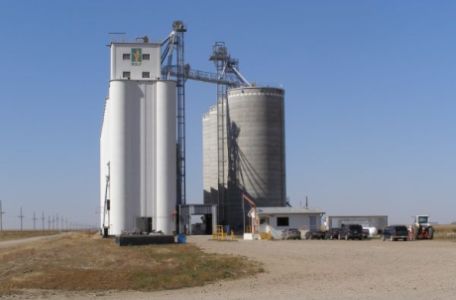Wolf Elevator
12835 W. Lowe Rd.
Deerfield, Kansas 67838
620-290-2648 (cell) Grains handled: Wheat, milo, corn, soybeans
Hours
: 7:30 AM – 5:00PM
Services
- Grain
Grains Handled
Wheat, Milo, Corn, Soybeans
WOLF HISTORY
The whole history of Garden City Co-op centers around small beginnings in many fields of services. “Mighty oaks, from little acorns grow”. Wolf Elevator didn’t even begin with Wolf Elevator but with the Peterson Elevator. According to old-timers, much of the virgin soil in the area surrounding the Wolf and Peterson stations was converted to crop land in years shortly before and after 1927. The 1931 crop year showed early in the year that it could be the largest crop the land had ever produced. Those prospects were fulfilled. Mr. Howard H. Everly, a former Garden City Co-op Manager, had been operating his own elevators in the county. He viewed the bright crop prospects and started building the Peterson Elevator in early 1931. The building job was pushed for completion to receive a prospective bumper 1931 wheat crop. He was not disappointed. That crop was the best of three preceding years.
Shortly after the 1931 crop, negotiations were launched to sell the Peterson Elevator to the members of Garden City Co-op. The following year, the deal was consummated. The Peterson Elevator continued to serve members in the area for several years and handled most of the grain grown in that neighborhood. The development of larger-scale farming operations soon pointed out the Peterson Elevator was becoming inadequate and obsolete. After consultation with members in the neighborhood, opinion crystallized toward a larger, better situated, grain handling elevator. The site chosen was the present location of the Wolf Elevator, about one and one-half miles West of Peterson Elevator. The Board of Directors, Management, and members’ belief that the Wolf location would better serve members in both Finney and Kearney Counties has been proved. The location West of Peterson is one-fourth mile East of the Finney-Kearney County line.
About August 1st, 1949, a 100,000 bushel, four-tank headhouse was started, and completed in November of the same year. Incorporated in the new grain receiving, and handling elevator was a 5,000 bushel per hour elevating leg, an electric man-lift, a heavy-duty truck hoist, and a 10-bushel automatic loading-out head-house scale. Simultaneously, the office was constructed and the truck scales were installed. The building that was built by the construction contractor for his use as a supply, tool-house, and office during the construction period was purchased by Garden City Co-op Board of Directors after the elevator was completed for use as a storage warehouse for feed, seed, oil, and grease. Once the Wolf Elevator was put into operation, the Peterson Elevator was used for emergency and extra storage space.
Filling the new elevator began immediately upon its completion near November 1, 1949. Grain receipts far out-stripped expectations and before many days had passed, the 100,000 bushels of space was chock-full while a greater part of the year’s milo crop was yet to be delivered to the elevator. One fact was forcibly driven home—this new elevator was not nearly large enough to serve the neighborhood. The remainder of that year’s crop was moved to terminal storage through boxcar loading to the Farmers Cooperative Commission Company in Hutchinson and other points wherever storage space was available.
In early 1950, petroleum handling facilities were added at the request of the members in the area. A 12,000 gallon above-ground storage tank, a 1,000 gallon under-ground tank, and an electrically driven dispensing pump was added.
Grain crops of 1950 through 1952 were received and handled, for the most part, on a receive-ship-out basis since the storage space in the elevator was generally full.
Plans were taking shape during the years, 1950-1953, and in September 1953, construction was begun on the first 315,000 bushel annex. It was completed in December of that year. The 13 additional tanks and 5 star bins brought storage capacity up to 415,000 bushels. The addition pretty well took care of the 1953 crop season but by the time the next harvest rolled around, there was no room to receive and store that crop. Again, it was necessary to resort to a receive-ship basis. A Hot Spot temperature detector system was added in early 1954 to insure a positive check against deterioration of stored grain.
Wheat and milo crops of the years through 1954 to 1957 were, of a necessity, received and handled much in the same manner as they had been when space was limited. A strong effort was expended to accumulate storage space prior to each harvest season to accommodate harvest deliveries but it was found each year, there was not enough space nor could boxcars be had in large enough numbers to keep the grain moving, consequently the elevator had to stop receiving grain many days during harvest season.
In January 1955, the warehouse was moved from its original site west of the office to its present site. It was placed on an elevated foundation at truck-bed level for easy loading and unloading. It was found that accurate weights from the automatic loading scales were almost impossible to obtain. A combination truck-track scale was installed in September 1957, to correct the condition. Now, not only could accurate loading-out weights be had, but also semi-trailer trucks could be accurately weighed. The whole loading-out operation was sped up since all weighing could be done at ground level instead of in the head-house a hundred feet above the ground.
A Hume-Fry continuous-flow grain dryer was added in November 1957. The extremely high-moisture milo crop that year forced the drying of well over a half-million bushels. The ever-present hazard of dust explosion was eliminated with the installation of a dust-control system in the spring of 1958. Strategically located suction hoods, along points where grain is moving in unconfined areas, prevent dust escaping into the air.
In spite of the original construction that replaced the Peterson Elevator and the building of the first annex, with their aggregate space of 415,000 bushels, the elevator could not keep pace with storage demands of the members. The annual problem, no receiving space, occurred every harvest season. Construction on a second annex was begun in early September 1958. The second annex, of twenty bins plus ten interstice or star bins, has 505,000 bushels capacity. It was completed November of that year and the filling of that space began in a short time following its completion. This new addition brought the Wolf Elevator to a total capacity of 913,000 bushels. With the addition of new capacity, changes and enlargement of machinery were necessary. The old 30 horsepower electric motor and elevating leg belt were replaced with a 40 horsepower motor and a correspondingly larger leg belt. This change increased the leg belt handling capacity to 6,500 bushels per hour.
For the most part, the storage space in the Wolf Elevator has been used to its fullest extent, with reservations for turning space. By careful management, it has been possible to accrue storage space before harvests the last few years by loading out early enough in the season to be ready to receive grain when the harvest starts. There have been very few times when it has been necessary to close up or limit delivery during the harvest season.


Area Grain Manager - Joe Varela - Cell: (620) 290-0401
